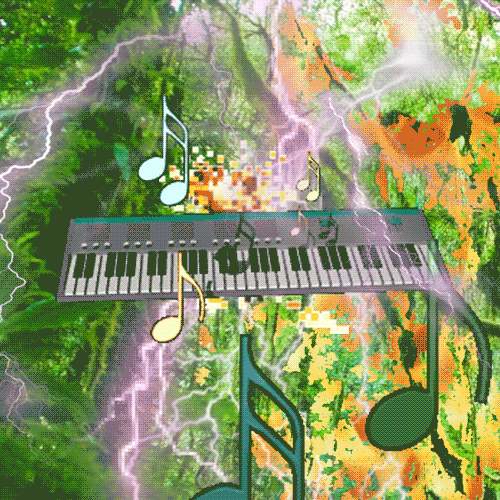In a country the size of Brazil, some musical styles never leave “home,” or their region. Brazil has a multitude of rhythms, from worldwide famous samba, pagode and forró, to lesser known regional styles such as carimbó or tecnobrega (also known as tecnomelody). Here, we’ll take a look at some of the styles found in the northern state of Pará.
From the mixture of several local styles – from carimbó to lambada, guitarrada, calypso and forró, along with Caribbean rhythms such as Trinidad and Tobago’s calypso – tecnobrega “appeared in Belém [Pará’s capital] in the early 2000s, from a confluence of factors. From a musical point of view, tecnobrega is a crossroads of the classic brega with elements of the eurodance that has dominated the parties in Belém since the late 1980s,” says Gustavo Godinho, director (with Vladimir Cunha) of the documentary “Brega S/A.”
“It’s a style that evolves all the time and every year there are new variations in the scene,” Ronaldo Lemos (professor at the Law at the State University of Rio de Janeiro (UERJ) and co-author of the book “Tecnobrega: O Pará reinventando o negócio da música”) tells Remezcla.
“The beginning of the 2000s was the period in which the first computers discarded by the middle and upper middle classes began to arrive in the periphery of Belém as scrap metal,” recalls Godinho. Some technicians collected spare parts and sold them at prices accessible to a low-income public, among them, DJs from the periphery of Belém. With the arrival of Lan Houses to such neighbourhoods, software such as Fruity Loops, for sequencing beats, started being used to record what soon became known as tecnobrega.

It is not known exactly who created the style, some say the band Tecno Show was the first. Yet others, such as Rafael Azevedo, musician and doctor in communication whose thesis dealt with the tecnobrega, point out that the origin of the style could be even older, in the mid-1990s, with Tonny Brasil and his Açaí Machine band.

Gabi Amarantos was the lead singer of Tecno Show, considered one of the precursors of the style (in activity between 2002-10) –https://www.youtube.com/watch?v=niGt6fhwMtA
“Tecnobrega emerged as a way to make brega through the use of digital production tools, with computers, lowering the cost of music production,” explains Azevedo, adding that “it emerged as a set of changes in the way of production of Pará’s traditional brega music that was very successful since the 80’s, with several substyles emerging, among them the tecnobrega.”

The style has revolutionized Brazilian music not only by combining the brega (a kitsch music style with lyrics about unrequited love and strong popular appeal) and more specifically a local version of brega, with electronic beats and regional rhythms, but by having created a new form of distribution and sale of music, “a very simplified production method and accessible to the poor and for having established an economic chain, even if precarious, self-sustainable and totally located in the periphery of the city, with some possibilities of expansion to the interior of Pará and nearby states,” explains Godinho.
However, explains Azevedo, tecnobrega “doesn’t emerge from an aesthetic program, from a group of people who articulate themselves to change the musical language that comes from a more conceptual critique. Brega is a music that is closely linked to dance, between two people, romantic, and because it is based on this appeal, tecnobrega is not exactly thought in the same way as the most traditional musical revolutions in Brazil, such as Bossa Nova.” The idea of revolution, then, can be understood as a market revolution, “for relying on what is against the industry, on piracy, on means of music production and distribution that are not linked to the traditional phonographic industry,” he adds.
Tecnobrega CDs are distributed free of charge, or sold at an affordable price in the streets by street vendors, and the music production does not require major studios and record labels – just a backyard room with “DJs/producers who often did not even know the names of the musical notes they used to compose their hits, but who managed to create a music that dialogued with the public,” says Godinho, sampling music from several national and international artists without concern for copyright and having in piracy, a fundamental ideology.
The songs are shared freely, also online, and the artists get this way and do not depend on radios or record companies, but profit from their shows and parties known as “Aparelhagem”, with modern sound, lighting and visual effects equipment. Then, “another culture of listening and dancing is created, linked to technology,” explains Azevedo.

Tecnobrega taught several lessons at a time when the music industry was in crisis and there were still no streaming services in Brazil, and “generated money with an innovative model at a time record labels were releasing 30 new records in Brazil, and technobrega released 400,” says Lemos.
Lemos also explains that “it all started with CDs distributed in street vendors, then went to the old MSN messenger and then to 4Shared, Youtube and so on. It is a changing scene both from the point of view of production and musical distribution.” In a sense, tecnobrega showed that “it was possible to use technology not only to produce popular music, but also to distribute that same music,” Lemos adds.
The industry behind tecnobrega is essentially informal. Godinho explains that “the concept of limiting the use of a work by imposing an author’s right on it is difficult to assimilate among those who make music.” The chorus of the song “Xirley,” Gaby Amarantos’ biggest hit, makes clear the ideology behind the musical style: “eu vou samplear, eu vou te roubar” that can be loosely translated as “I’m going to sample, I’m going to rob you.”
Like Rio de Janeiro’s funk, tecnobrega was born in the periphery of a big city, being produced by the population excluded from the big markets, says Azevedo, which finds ways to express themselves artistically and soon breaking the barrier of exclusion, with artists making success and exporting the musical style, but with a scene still treated with prejudice and distrust – even though the episodes of criminalization and violence involving funk are not common within tecnobrega scene.




